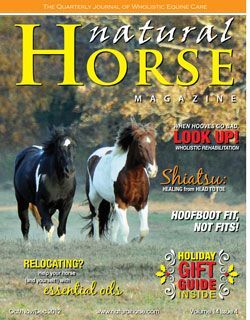
Thrush in overgrown hoof
This blurb is in response to a topic on a forum concerning the best treatment for a thrushy hoof. It became apparent that the difference between Thrush and Yeast of the Equine Hoof was not widely understood. Hopefully this helped:
I’m only going to address this one more time as I don’t wish to argue “facts”. Normally I wouldn’t bother however a few treatments that are commonly used for Hoof Thrush (Fusobacterium necrophorum ) and dead thrush bacteria actually FEED Candida albicans (Yeast/Fungi) and causes proliferation of that disease in the hoof.
“Thrush”, in an Equine Hoof, is NOT the same as “Thrush” in the human system. Equine Hoof THRUSH is Fusobacterium necrophorum — a Gram-negative, non-spore-forming anaerobe and is a normal inhabitant of the alimentary tract of animals and humans.
“Yeast”, in an Equine Hoof, is Candida albicans — it is found in the gastrointestinal tract and in immunocompromised individuals can cause a variety of dis-eases within the body, including the hooves of the horse.
Yeast feeds off sugars and DEAD THRUSH BACTERIA and will proliferate without proper attention to, not only the hooves, but the entire system of the horse causing many secondary conditions including cancers.
Again, this is my last post on this topic. Take it as you will. But know that one can treat HOOF THRUSH til the cows come home but if the YEAST, that may also be present, is not also addressed then it will proliferate on the dead thrush bacteria and the hooves will continue to deteriorate.
Fusobacterium necrophorum requires anti-bacterial treatment for gram-negative bacteria while Candida albicans require anti-fungals.
TOPICALS: Tea Tree Oil and Oregano Oil were both mentioned which are both anti-bacterial AND anti-fungal in nature so are effective. I must warn that Oregano Oil is EXTREMELY strong and may burn the skin if applied without a carrier oil !!! Bleach damages live tissue as Formeldehyde does (found in a few commercial Thrush treatments. Hydrogen Pyroxide will lower the pH thus causing death to both the bacteria AND the fungii and is a relatively ‘safe’ product to use. Copper sulfate is also a VERY effective topical/soak and is also a great systemic addition to the daily ration.
SYSTEMIC: As I mentioned before, Candida albicans is a SYSTEMIC condition and in addition to topical treatment of the hooves the immune system must also be treated. PROCESSED food cause leukocytosis which weakens the immune system and allows other imbalances to affect the body. There are LIVE FOODS (vegetables, herbs, fruits, nuts, seeds) that will STRENGTHEN the immune system AND, some have anti-fungal properties that will address the systemic yeast. Again, Copper sulfate can be added to the daily ration (1/2 tsp. per day: some dark colored horses may need 1 tsp a day). Extra Vitamin C will also help to boost the immune system as will some herbs such as Echinacea and Astragulus. Dried herb can be added daily (1 oz.) to the daily feed.











Thank you Catherine, for sharing! 🙂 🙂 🙂
Catherine Ritlaw of http://www.jersanctuary.org is generous to share HER home-made thrush spray that she uses on the rescues. It sounds WONDERFUL! ::
“We now make our own hoof remedy for fighting thrush. I add 1/2 oz. Nutribiotic grapefruit seed extract, 1/2 oz. tea tree oil, 1 oz. oregano oil an 1 oz. goldenseal extract to a quart spray bottle and fill it with cheap vodka (40% grain alcohol). Combined with frequent natural trimming and thorough hoof cleaning with a hoof pick and wire brush, it is working well:
http://www.vitacost.com/NSI-GoldenSeal-Root
http://www.vitacost.com/NutriBiotic-GSE-Liquid-Concentrate-Grapefruit-Seed-Extract
http://www.vitacost.com/NSI-Oregano-Oil
http://www.vitacost.com/NSI-100-Pure-Tea-Tree-Oil “